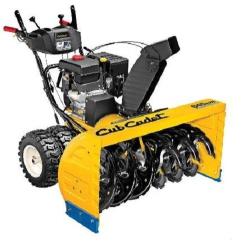 Proper care of your Cub Cadet small engine is important to get the performance you expect out of it for as long as you need to use it. Properly maintained, your lawn and garden equipment can last you for years without any appreciable decline in performance. The most basic care includes using the right oil and fuel your engine was built for.
Proper care of your Cub Cadet small engine is important to get the performance you expect out of it for as long as you need to use it. Properly maintained, your lawn and garden equipment can last you for years without any appreciable decline in performance. The most basic care includes using the right oil and fuel your engine was built for.
Small engines come in two main varieties: two-cycle and four-cycle. The number describes the piston movements for every ignition of the spark plug. In a two-cycle or two-stroke engine, there is a compression stroke, followed by ignition and the power stroke. The return stroke is when the new fuel mixture is injected into the cylinder, where it is compressed and ignited again. A four-stroke engine divides the compression strokes and the exhaust strokes (with each having a corresponding return stroke).
For small engines, it is easy to tell if you have a two-cycle or four-cycle engine: if it has a dipstick anywhere on the machine to check oil level, it’s a four-cycle, because two-cycles lack a dedicated lubrication system. Instead, two-stroke engines mix the oil in with the fuel to provide the necessary lubrication.
The two-cycle engine has a few marked advantages over its four-stroke cousin. Two stroke engines are easier to construct, weigh less, and cost less to manufacture, meaning you get considerable savings as a consumer. In addition, because they have a power stroke on every revolution, a two-stroke engine will effectively have twice the power of a four-stroke counterpart for the same engine size.
The downside is that two-cycle small engines like those used in some Cub Cadet equipment do not have a dedicated lubricant system, so small amounts of oil need to be mixed with the fuel to lubricate the crankshaft, cylinder walls, and connecting rod (other concerns, such as reduced fuel efficiency, are generally only noticeable if used for heavier equipment such as a car). For this reason, it is vital that you research the proper fuel and oil mixture for your equipment to reduce wear and improve its lifespan.
Four-cycle engines tend to have longer lifespans with their separate oil lubrication reservoirs. The engine tends to stay lubricated better, the four stroke mechanism is less punishing on the engine as a whole, and the engine tends to go through oil at a much slower pace since the oil is not burned, saving some cost over the long run.
Fuel-oil mixture for two-cycle engines
The exact mixing ratio between oil and fuel for a 2-cycle engine depends on the exact engine you are working with. The operator’s manual will always specify the proper ratio to use. At the most, you will use a sixteen to one ratio of fuel to oil. For some engines, that ratio drops dramatically to a fifty to one ratio of gasoline to oil.
Always mix the fuel and oil thoroughly in a separate container before pouring it into the fuel tank of your engine: attempting to simply add them individually to the fuel tank makes achieving the proper ratio more difficult, and may cause problems with the components not mixing adequately. Also avoid using any fuel over 30 days old. Gasoline tends to go stale quickly, affecting the consistency and the combustibility. Use of old gasoline may cause your engine to stall or fail to start entirely.
Identifying the proper oil for your Cub Cadet
While a four-cycle engine typically requires less oil overall, it is by no means less vital. Be certain to check your engine oil level before every use to ensure it is adequate; else you may be reducing the lifespan of your equipment. It is normal for a small engine to use up to an ounce of oil per cylinder per hour with normal use, varying somewhat depending on the oil used.
Which oil you should use depends on what Cub Cadet product you own. For a Briggs & Stratton engine, go for an SAE30 oil for temperatures above 40 degrees Fahrenheit. Tecumseh and Kohler L-Head engines also use an SAE30 oil as long as the temperature is above freezing (32 degrees Fahrenheit). The Kohler Overhead Valve engine should use a 10W-30 oil above 0 degrees Fahrenheit. Honda engines are recommended to use a 10W-30 oil for all general use, though above 55 degrees you may switch to SAE30. For all non-Honda engines, below the stated temperature for that make, change to a 5W-30 oil for proper performance.
Where to buy Cub Cadet engine oil
It is strongly recommended you purchase oil certified as Cub Cadet-compatible from a reputable parts and supply dealer. www.cubparts.com has a selection of appropriate oil for top performance in a wide range of Cub Cadet engines.
